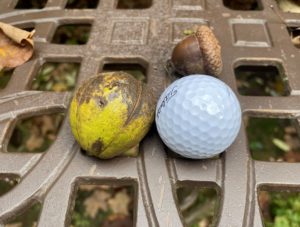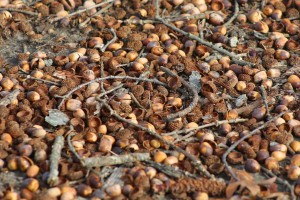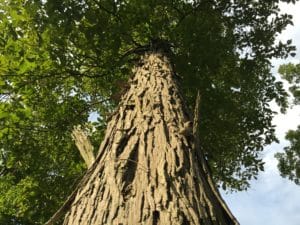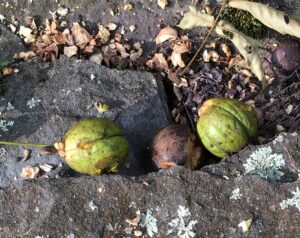Hello, Fellow Readers, These are nutty times. Far nuttier than usual in my neck of the woods. The Shagbark Hickory nuts are overabundant and golf ball and size, so much so that walking amongst them is risky for ankle stability. It’s called masting when there’s an excess of nuts, but how do trees know when to dial up the volume in mast years?
A few years ago, I had the privilege of attending Dr. Doug Tallamy’s talk about his book The Nature of Oaks, which I highly recommend. He spoke about why there aren’t the same number of nuts each year, Mother Nature’s way of checks and balances of controlling populations, called predator satiation.
Nature’s way of controlling populations
In a nutshell, (I couldn’t resist) the hypothesis is same species of plants simultaneously produce more seeds or nuts than can be consumed by animals so that the plant will have plentiful seeds and nuts to reproduce. And other years, when there are only a few or no nuts, squirrels, chipmunks, blue Jays, turkeys, etc., may starve, keeping populations in check.

A Beyond Nutty Mast Year
Large oaks can produce 10,000 acorns in a mast year – 10 to 20 times more than average, and trees grow more slowly when masting as they put energy into making nuts.
We’ve all heard the folklore that an abundance of nuts means a severe winter ahead, right up there with a theory that the narrower the brown band on woolly bear caterpillars, the harsher the winter, but neither is scientifically proven.
Trees grow more slowly during the Mast Years.
Scientists aren’t precisely sure what causes mast years, though theories of environmental reasons, available pollen, and chemical signaling are likely. Certainly, untimely spring freezes can kill fruit-bearing buds, and wet and cold springs can impact pollination, just as dry, hot summers influence the size of fruits and nuts. But, the specific triggers for mast years, which occur every two to five years, are not definitive.
My adored Shagbark Hickories (Carya ovata) are native trees. Its common name speaks for itself with a shaggy bark that stands out like a sculpture. But a treasure to some can be a nuisance to others. It’s true the first time a golf ball-sized nut thumped my head, it was a stinging surprise. Then there’s the feeling of walking on marbles during the fall nut drop.
Still, I’m glad the bear, fox, rabbits, squirrels, raccoons, and turkeys enjoy the nuts before tackling the cleanup, making the task far lighter to manage. Jolee also loves the nuts, which is becoming an afternoon feast. That is after she chases the squirrels, her favorite sport. While I have not tried them, I heard that the nuts taste very similar to pecans, which are also in the walnut family.

Shagbark Hickory
Shagbark Hickories as a Shade Tree
I never had a client request planting a Shagbark Hickory as a shade tree until this week when new clients in Morristown suggested we install a Shagbark Hickory rather than the planned Red Oak, the New Jersey State tree. They said the Shagbark Hickory would pollinate the Pecan tree as they are from the same family. Mother Nature is so clever.
Shagbark Hickory produces juglone, a natural herbicide. Still, in far less concentration than Eastern Black Walnut, so as far as I know, there are no plants to avoid around Shagbark Hickory.
The cycle of Shagbark Hickory Nuts

Shagbark Hickory Nuts- Before Squirrels
Once Shagbark Hickory trees are old enough to bear fruit, they will produce nuts in three-year cycles. In the first year of that cycle, the tree will yield a massive bounty, as many as 18 gallons of nuts – almost four 5-gallon buckets full from a single tree. Then, there will be about 10 gallons in year two, and in year three, the tree will be nutless. No wonder leaf cleanup didn’t come with the usual wheelbarrows full of nut-raking last year.
The cycles of nature, the unique ways things unfold, and how nature keeps things in balance are miraculous if we don’t mess things up. And while we may feel small compared to the whole world, we can play a significant role in helping each other and helping nature. It’s about being kind.
Garden Dilemmas? AskMaryStone@gmail.com and your favorite Podcast App.
There’s much more in the Garden Dilemmas Podcast, including a story of a fellow gathering Black Walnuts along the road to help wildlife:
Related Stories (and Podcast Episodes) and Helpful Links:
Fruits and Veggies near Black Walnut
More about Dr. Doug Tallamy’s talk – Native Plants, especially Oaks, are Essential, and his book Nature of Oaks
Related Podcast Ep 32. Juglone Companions, Fascinating Fasciation



I have enjoyed Hickory nuts since I was a small child. I am from a family of 7 children. We played outside a lot. A favorite pastime was cracking and eating hickory nuts. Now 59 years old I re discovered my love for hickory nuts. Easing into retirement, I realize I need some healthy outdoor activities. Hunting for hickory trees is my latest obsession. My older sister Karen recently told me she remembers that hickory nut tree. She announced this when I gave her a taste of a hickory nut. It was a flavor inspired memory. She tasted that nut and instantly recalled that huge shagbark hickory in back of our house in Seneca Knolls, NY. I watched her upload map quest on my phone and punched in the address of our old house. There on the screen was the hickory tree, my old friend, sitting in the field.
Hello Paul, Such fun to read about your long history with Hickory Nuts. And that your beloved tree still stands!
Thank you for sharing and for reading my column, Mary Stone
What a lovely article.
We have a large grove of hickories. There were two huge old trees (100++ years old) for many years, while we were pasturing cows in the area. We sold the cows 40 years ago and the grove has grown to more than 50 trees.
Thank you, Leslie, for your kind words and for reading my story. 100-year-old Shagbark Hickories! I’ll bet they are stunning. Imagine how many animals their 50 offspring feed. A beautiful thing. I appreciate you taking the time to share, Mary Stone
We are having a heck of a time this year keeping up — it’s not just the nuts, but the daily carnage of squirrel-chewed leftovers. We could sweep the deck twice a day and not keep up. How long will they keep falling? And we’ve been in this house ten years, and never remember them being this bad. Is it an especially abundant mast year? Thanks!
Hi Sarah, Here in Northern New Jersey, Shagbark hickory nuts typically fall to the ground from mid-to-late September through October. Squirrels help them along by nibbling off branches so the nuts fall. It does make a mess, but wildlife is happy. Raking up the uneaten nuts in the lawn (it’s like walking on golf balls) adds to the fun. But I have to say, I adore the shaggy bark of the trees and glorious fall color. Hang in there, this too shall pass. Smile. Thanks for reading my post, Mary Stone
Hello everyone, greetings from southern Indiana. My wife and I retired here in 2005 after a 25 year career in the military. We purchased a new house situated in the country on 2 acres with lots of trees. Little did we know that at least 100 trees were Shagbark Hickory. We found out the following summer when green hickory nuts started slowly falling all around us. I would be out under a tree raking up nuts and the squirrels would be up in the tree working on the nuts and it would literally be raining pieces of nuts on me as I was raking! I’m 64 now and it’s hard keeping them cleaned up. I try to wait until most of them have fallen and then do a clean up. The squirrels love our place though. It’s like all you can eat for them! I have found that a good backpack blower comes in very handy when its clean up time to push the nuts into a pile. Then I rake them into a huge dust pan and into a wheel barrow.
I adore your optimistic outlook, Mike —think of how much wildlife your 100 trees are feeding! Thanks for sharing your tips and for reading my post.
I am giggling, remembering when I first discovered how large shagbark hickory nuts are. I was gardening and one fell on my head. Ouch! Hence why they may not make the best shade trees for a lawn unless you wear your bike helmet during the nutty time of the year. Smile. An occasional nut drop to the head is well worth it, though. I love their shaggy bark all year round. Your property sounds heavenly. Thanks for writing in, Mary
Hello from upstate NY,
We have a few nut producing shag bark hickories on our property and a few young shag bark hickories. The biggest one has a diameter of 20 inches (3 foot from the ground). Any idea how old this tree is? I don’t have any way to measure its height. But it is bigger than the red oak I did harvest/pickup some of the shedded bark and plan on making hickory syrup.
Hi James, from what I found, your tree is likely about 150 years old. There’s a formula for measuring the diameter of the tree at 4.5 feet and multiplying it by the growth factor of the species. They say for Shagbark Hickory it’s 7.5. Your measurement at 3 feet is below the “chest high” of 4.5 feet. Additionally, site conditions, such as the amount of rain and sunshine, have an impact on the size of the tree. But you sure have a big tree!
I never heard of Hickory Syrup made from shredded bark. So, of course, I dug into learning after you forage bark from shagbark hickory (Carya ovata), you clean, roast, and boil it to create a tea. Then add sugar, boiling it down consistency of syrup. I found a recipe from Alan Bergo of Forager Chef. How fun! Thanks for reading my post and adding your comments to it. I adore learning about new things. Mary Stone